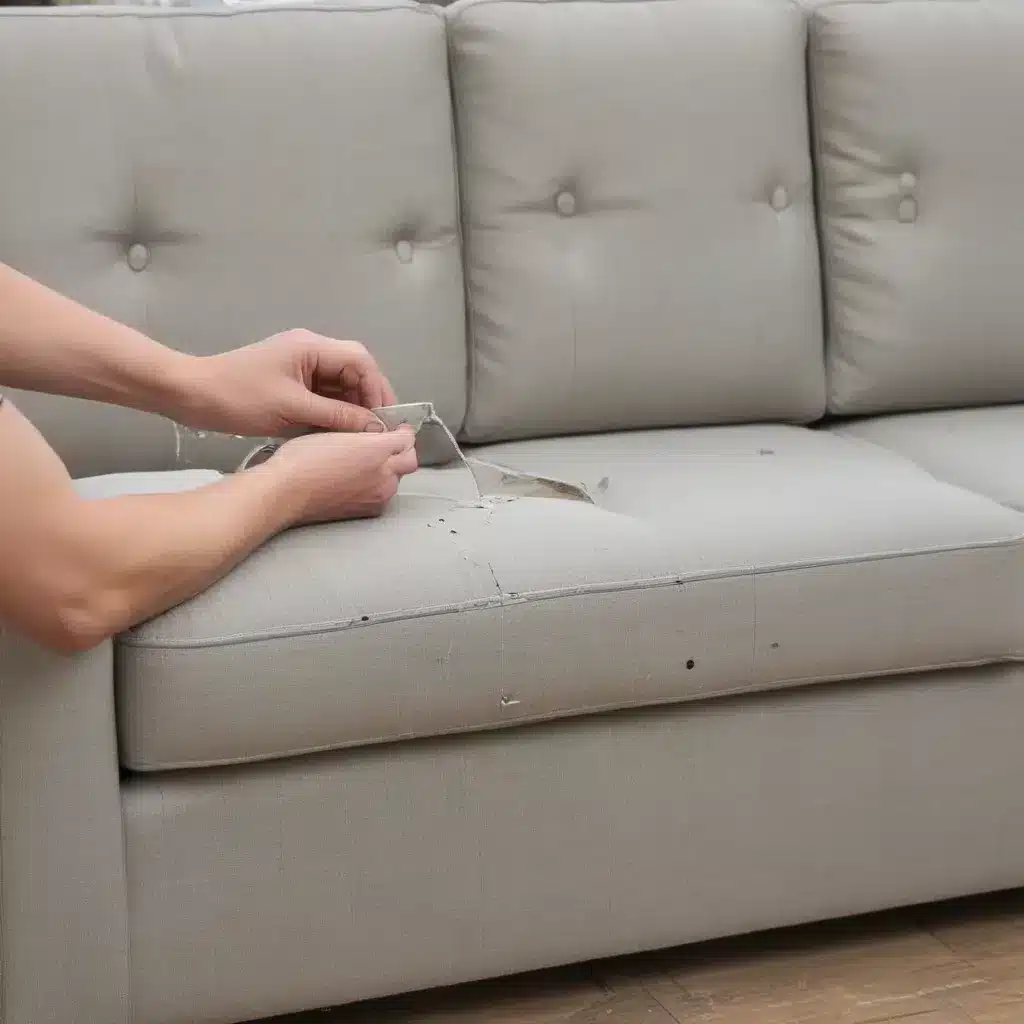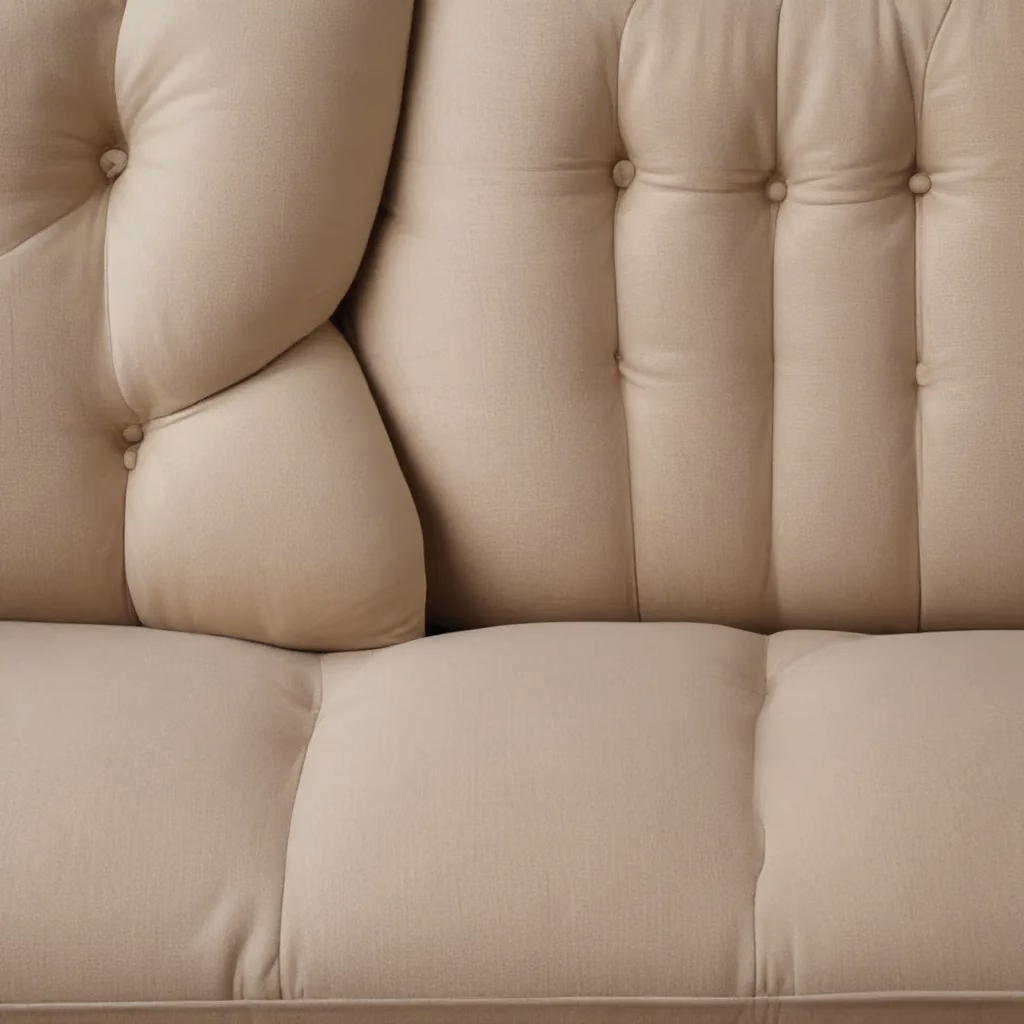Oof, nothing quite ruins the cozy comfort of your favorite sofa like a nasty rip or tear, am I right? I’ve been there, my friend. One minute you’re sinking into the plush cushions, remote in hand, ready to binge-watch the latest must-see series, and the next – BOOM. Your trusty sidekick has betrayed you with a gaping hole or a loose seam. Talk about a mood killer.
But fear not, brave sofa-dweller! I’m here to walk you through the step-by-step process of patching those pesky holes and repairing those unsightly seams, so you can get back to living your best couch-potato life.
Preparing for the Repair
First things first, let’s make sure we have all the necessary tools and materials on hand. You’ll need a curved upholstery needle, some heavy-duty nylon thread (preferably color-matched to your sofa), a small piece of fabric that matches your sofa’s upholstery, and a pair of sharp scissors. Oh, and don’t forget your trusty sidekick – a pair of needle-nose pliers. You know, the ones you’ve been meaning to use for something other than getting that stubborn jar lid off.
As demonstrated in this helpful video, you can actually create your own curved upholstery needle by bending a regular crewel embroidery needle with those pliers. It might not be perfect, but it’ll get the job done in a pinch.
Now, before you start poking and prodding at your precious sofa, take a moment to assess the damage. Is it a small hole or a longer seam tear? Knowing the extent of the issue will help you determine the best approach. And let’s be real, no one wants to end up with a sofa that looks like it’s been through a warzone, right?
Patching Small Holes
Okay, let’s start with those pesky little holes. These can be a real pain, but with a little care and patience, you can have them fixed up in no time.
First, grab that piece of fabric that matches your sofa’s upholstery. You’ll want to cut a small, oval-shaped patch that’s slightly larger than the hole. This will give you some overlap to work with and help ensure a secure, seamless repair.
Next, thread your curved needle with that heavy-duty nylon thread. As the experts at Makezine suggest, you’ll want to use a double thread for added strength and durability.
Now, gently place the fabric patch over the hole, making sure the edges line up nicely. Using your curved needle, start stitching around the perimeter of the patch, taking small, even stitches. Be sure to keep your stitches tight and close together to create a secure hold.
As you stitch, try to mimic the existing pattern or texture of the sofa’s fabric. This will help the patch blend in seamlessly. And don’t be afraid to play around with the tension of your stitches – you want them to be snug, but not so tight that they start to pucker the fabric.
Once you’ve completed the stitching, use a pair of sharp scissors to trim any excess fabric around the edges of the patch. And voila! Your small hole is now a thing of the past.
Repairing Seam Damage
Ah, the dreaded seam tear – the bane of every sofa owner’s existence. But fear not, my friend, for I have the secret to conquering this pesky problem.
First, take a close look at the seam damage and determine the extent of the issue. Is it a small separation, or has the seam completely unraveled? Knowing the severity will help you decide on the best course of action.
If it’s a minor separation, you can try a quick and easy fix. Simply thread your curved needle with that trusty nylon thread and start stitching the seam back together. Take small, even stitches, making sure to catch both sides of the fabric. Be gentle, but firm, and try to match the existing stitching pattern as closely as possible.
Now, if the seam has completely come undone, you’ll need to take a slightly more involved approach. As demonstrated in this helpful video, you’ll want to start by carefully removing any loose or frayed threads along the seam. This will give you a clean surface to work with.
Next, take your piece of matching fabric and fold it in half to create a small, double-layered patch. Position this patch over the seam, making sure the edges line up nicely. Then, using your curved needle and nylon thread, start stitching the patch in place, taking small, tight stitches to secure it.
As you stitch, try to mimic the existing seam pattern as closely as possible. This will help the repair blend in seamlessly with the rest of the sofa’s upholstery. And be sure to keep your stitches nice and tight – you don’t want any unsightly gaps or puckering.
Once you’ve completed the stitching, give the area a good once-over and trim any loose threads or excess fabric. And just like that, your sofa’s seam is back in tip-top shape!
Maintaining Your Sofa’s Condition
Now that you’ve conquered the repair game, it’s time to talk a little bit about sofa maintenance. After all, the best way to avoid future tears and holes is to take good care of your beloved couch in the first place.
One of the most important things you can do is to regularly vacuum and brush the upholstery. This will help remove any dirt, crumbs, or debris that could potentially work their way into the fabric and cause damage over time. And don’t forget to get into those nooks and crannies – you’d be surprised how much gunk can accumulate in those hard-to-reach areas.
Another key tip? Avoid letting your pets (or your kids, let’s be real) have free rein on the sofa. Those sharp little claws and bouncing bodies can wreak havoc on even the sturdiest of upholstery. If you must let them up, consider investing in some cozy throw blankets or cushions to create a barrier between their shenanigans and your precious sofa.
And last but not least, be mindful of where you place your sofa. Direct sunlight can fade and weaken the fabric over time, so try to position your couch away from any bright windows or high-traffic areas. And if you do notice the fabric starting to look a little worse for wear, don’t hesitate to give the good folks at Sofa Spectacular a call. They can work their magic and have your sofa looking brand new in no time.
So there you have it, my fellow sofa enthusiasts – the ultimate guide to patching holes and repairing seam damage. With a little bit of elbow grease and a whole lot of care, you can keep your beloved couch looking its absolute best for years to come. Now, where did I put that remote…?




